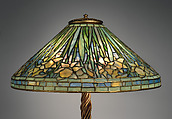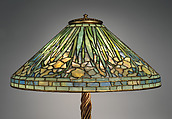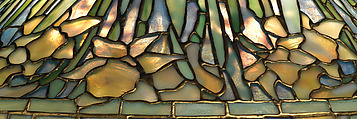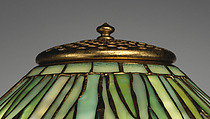"Daffodil" lamp
Manufacturer Tiffany Studios
This Daffodil lamp is an exemplar in illustrating Tiffany’s lifelong interest in the natural world, and the inspiration he drew from it for his artwork. The artist and his designers experienced nature firsthand, often working from live studies and sketches. Archival photographs of the studio show staged model shades with clipped daffodils, demonstrating the importance of crafting the glass shades directly from nature.
The initial artistry for Tiffany’s lamps—made in multiples and crafted from established models and cartoons—derived from the designer. Additional artistry was provided by the "Tiffany girls," the women who were involved in the selection and cutting of the individual glass pieces, and their selections provided the different variations of a particular model. This specific example of the daffodil shade reveals the enormous sensitivity on the part of the selector, as can be seen in the soft palette and subtle color transitions. The shade is paired with a Twisted Vine base, an additional reference to the natural world of Tiffany’s inspiration. Both the shade and the bronze base feature a gilt finish that complements the coloring of the glass used in the shade.
The Daffodil design seems to have been popular over several decades. The first published version of the pattern dates to 1904, when it appeared in the Studios’ advertising pamphlet titled Bronze Lamps. It appeared in subsequent published Price Lists, and in the Lamp ledger book dating to 1922-24 (collection of the Metropolitan Museum), where it was recorded that some nineteen examples were executed, a relatively high number of a single pattern.
Due to rights restrictions, this image cannot be enlarged, viewed at full screen, or downloaded.
This artwork is meant to be viewed from right to left. Scroll left to view more.







